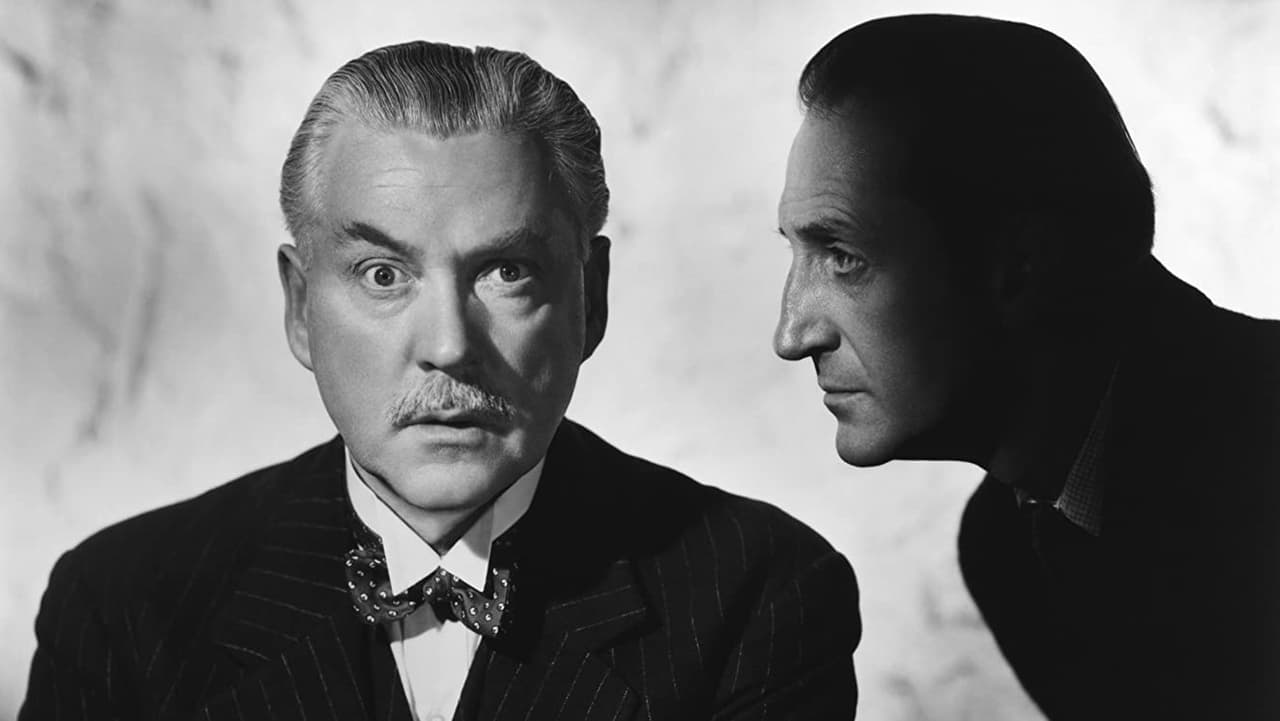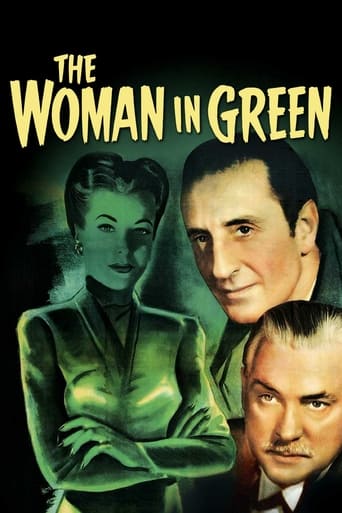

This movie was so-so. It had it's moments, but wasn't the greatest.
... View MoreI have absolutely never seen anything like this movie before. You have to see this movie.
... View MoreJust intense enough to provide a much-needed diversion, just lightweight enough to make you forget about it soon after it’s over. It’s not exactly “good,” per se, but it does what it sets out to do in terms of putting us on edge, which makes it … successful?
... View MoreWorth seeing just to witness how winsome it is.
... View MoreTHE WOMAN IN GREEN (Universal, 1945), produced and directed by Roy William Neil, the ninth installment of the modernized "Sherlock Holmes" mysteries for Universal (1942-1946), and eleventh featuring Basil Rathbone (Sherlock Holmes) and Nigel Bruce (Doctor Watson) in their legendary roles, is, regardless of contradictions from previous theatrical episodes, another interesting entry in the series. Along with some repeat performers in support, Hillary Brooke and Henry Daniell, who've assumed other character parts from earlier products in the franchise, would become central figures this time around, matching wits with the famed detective in another baffling mystery.The opening passage starts with an off-screen narrator, Inspector Gregson, filling in to what's to be presented as the police force come to the Scotland Yard building entrance: "I won't forget that morning, not if I ever live to be 100. I counted the men as they marched out of the yard. They hardly slept for weeks. We of the C.I.D. slept even less, but the nightmare that kept us awake was all the same nightmare. That's why we weren't surprised when the commissioner asked us up for the conference room for a bit of a talk. He talked to us plenty. We knew that! They didn't help any to know what was asked of them." The commissioner holds a staff meeting involving the most ghastly murders to take place on the streets of London since Jack the Ripper where the female victims are found with their forefingers amputated following their deaths. Having no clues nor motives has everyone stumped. A fourth murder soon takes place in Lambert Way, having Inspector Gregson (Matthew Boulton) notifying Sherlock Holmes (Basil Rathbone) for expert assistance. Observing the bodies in the mortuary, Holmes comes to the conclusion the murders are done by a skilled surgeon. However, Sir George Fenwick (Paul Cavanaugh), a lonely middle-aged widower who's been dining with "a handsome woman," Lydia Marlowe (Hillary Brooke), leaves the Penbroke House Club to her apartment for a nightcap where her maid, Crandon (Sally Shepherd) acts mysteriously during his visit. The next morning, Fenwick awakens in a boarding house on Edgeware Road, confused, unaware of how he got there, not accounting for the lost ten hours in amnesiac state. With another murder having taken place nearby, Fenwick believes he's responsible for the crimes when he finds an amputated forefinger in one of his pockets. Later, Fenwick is found murdered, much to the shock of his daughter, Maude (Eve Amber), who had witnessed her father the other night burying evidence of the forefinger in his garden. Discovering Fenwick was being blackmailed for crimes for which he is innocent, Holmes points his finger on Professor Moriarty (Henry Daniell) responsible for the crimes, which seems impossible since his nemesis is dead. Or is he? Throughout it all, THE WOMAN IN GREEN has the distinction of having two different stories for the price of one. It starts off splendidly in typical murder mystery fashion, but once Moriarty (spelled Moriarity in the cast credits) makes his appearance, the story shifts to another direction involving hypnotism. George Zucco and Lionel Atwill, who appeared earlier as Moriarty under Rathbone, each coming to plunging to their deaths conclusion, is now resurrected in the physical being and slightly younger Henry Daniell. Contradiction sets in when Holmes' amiable assistant, Watson, mentions Moriarty was "hanged in Montevideo over a year ago." If so, how about the fatal ends of Zucco and Atwill's Moriarty? Now Morarity has somehow survived his execution in the gallows and is alive and well once more. The idea of Holmes and Moriarty coming face to face again benefits the story greatly. Bertram Millhauser, credited for original screenplay, obviously didn't bother about the earlier films to keep the stories intact. Maybe having Daniell as Moriarty's brother or nephew might have sufficed. Overlooking these factual errors, THE WOMAN IN GREEN is well scripted as is. While there's an interesting segment where Watson gets hypnotized at the Mesmer Club by Doctor Onslow (Frederick Worlock), the true highlight belongs to Holmes when going into a trance by one of Moriarty's assistants, the titled character, who's never referred to in the story as "The Woman in Green." While Mary Gordon returns as Mrs. Hudson, series regular Dennis Hoey is absent this time around as Inspector Lestrade.Distributed to home video in the 1980s, and eventually DVD, THE WOMAN IN GREEN, which has fallen into public domain, has appeared on numerous television and cable television channels over the years, one of them being Turner Classic Movies (TCM premiere: March 8, 2004). Next installment: THE HOUSE OF FEAR. (**1/2)
... View MoreThe woman in green is actually a dull, the plot is straight forward but the direction and the plot itself were just not good enough for you to appreciate it. The movie featured Sherlock's Holmes arch enemy, Professor Moriarty who is suppose to be Holmes intellectual equal, but in this flick he seemed to look more like a struggling villain trying to live out a fantasy of being the man to kill Holmes.The woman in Green is a 1945 American crime drama thriller starring Sir Arthur Conan Doyle's detective Sherlock Holmes, his faithful companion Dr. Watson and Professor Moriarty all this characters were created by Doyle. The movie is the eleventh film to star both Basil Rathbone and Nigel Bruce as Sherlock Holmes and Dr. Watson respectively. The movie is not directly based on any of Sir Arthur Conan Doyle's stories and books on Sherlock Holmes, the movie is credited to have an original screenplay, but several of its scenes can be said to have been lifted from "The Final Problem" and "The Adventure of the Empty House." The movie plot starts with a string of random murders of women who then have their forefingers severed. These acts made Scotland Yard think that there is a serial killer on the loose and Sherlock is called upon for aid. During his investigation he and Watson, stumbled upon a clue after a deceased man's daughter brought them a forefinger believed to be belonging to one of the dead women. Sherlock was able to deduce from the incident that some high power is at play here, not just a mere serial killer. His obsession with the fact Moriarty is not dead made him to conclude that Moriarty is back and is the man behind all the murders. His believe came true when he got a visit from Moriarty himself, and he got another lead in the case when a man was sent to kill him and the man didn't even seem to know what he was doing.Although owning all the Rathbone/Bruce series will be a nice collection for any movie collector, I won't try and stop you from collecting this movie, but as I said it is a low for me, the high I got when I saw The Hounds of the Baskerville's (1939) kind of like vanished half way through this one, this post World War II movie, is a little dry for my taste.www.lagsreviews.com
... View MoreWoman in Green, The (1945) *** (out of 4) Eleventh film in the Basil Rathbone series has him once again playing Holmes and this time trying to crack the mysterious case of women being murdered and having their right forefingers cut off. With the help of Watson (Nigel Bruce) the two put the pieces together and they of course lead to Moriarty (Henry Daniell). This here is certainly one of the better entries in the series as we get a pretty dark and morbid story to mix in with the great performances. Neill does a terrific job directing the picture and I love the visual look that he gives the film. There are a lot of dark shadows that give the film an unmistakable atmosphere that really helps the storyline. Having a serial killer used in the film isn't all too shocking but the fact that he's cutting off the victim's fingers just gives the film a darker edge that many other mysterious from this era don't have. As to be expected, Rathbone is terrific as Holmes and it certainly hadn't ran out of gas with the character. As always what makes Rathbone so great in the role is that we actually believe he's this intelligent man who could solve anything thrown his way. Bruce is also up to his usual high standards and Hillary Brooke makes for a great femme fetale as she has an extremely dark and sexy look to her that perfectly fits her character. Daniell also makes for a very good Moriarty as he's strong enough of an actor where we can believe him to be this wise villain.
... View MoreThere is a vile murderer lose in London, not since the terror of Jack The Ripper has London been subjected to such gruesome doings. The killers trademark is that he severs the forefingers of his victims, the police are baffled. Enter Holmes and Watson, called into action once again, but even the intrepid Holmes is baffled. There is more to the case than meets the eye, and could there be on old adversary behind the murders?.The Woman in Green is the eleventh of the fourteen Sherlock Holmes film's starring Basil Rathbone as Holmes and Nigel Bruce as Dr. Watson, and the eighth of the eleven directed by Roy William Neill. Partly based around Arthur Conan Doyle's-The Adventure of the Empty House, The Woman In Green {ambigious title in context of the films content} continues the dark path trodden in the previous film, House of Fear (1945). As Holmes ruefully observes another female victim on the slab in the mortuary he muses "fiend that did this," and then promises to crack the case. It's Holmes obsession with the case, and the macabre nature of the story that carries the audience thru it's very chatty first half. That the darkness lifts at the midpoint is no bad thing due to the introduction of a rather well known foe from Holmes' past. However one has to wonder, as good as the "twist" is, if the film would have been better off staying in darker territory? You see the second half eases in tone as Watson slips into, what is admittedly always great fun, comedy mode and the babe of the piece {a smashing Hillary Brooke} becomes focal along with he who shall not be named. It works of course, this is Holmes trying to crack a devilish case, one that will encompass a new form of trickery in the pantheon of villainy. And then there is some fabulous shots used by Neill, one particular sequence involving swirling water and a white flower is very memorable. While the ending, in true Holmes, Watson and villain style, does its job all told. It's just one can't help feeling that this should have been far better than it eventually turned out to be. Still a fine series entry mind, and arguably the last time a Rathbone film had that delicious dark undercurrent to it. 7/10
... View More